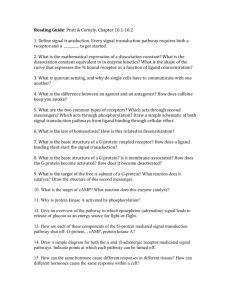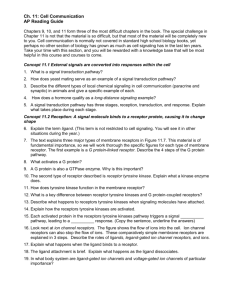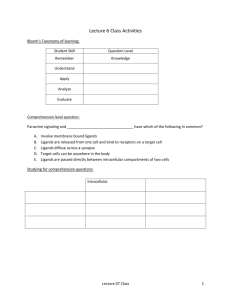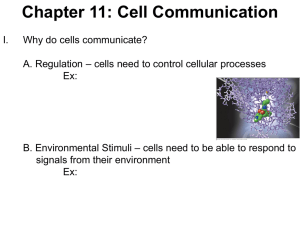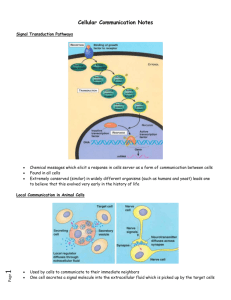6Communication
advertisement
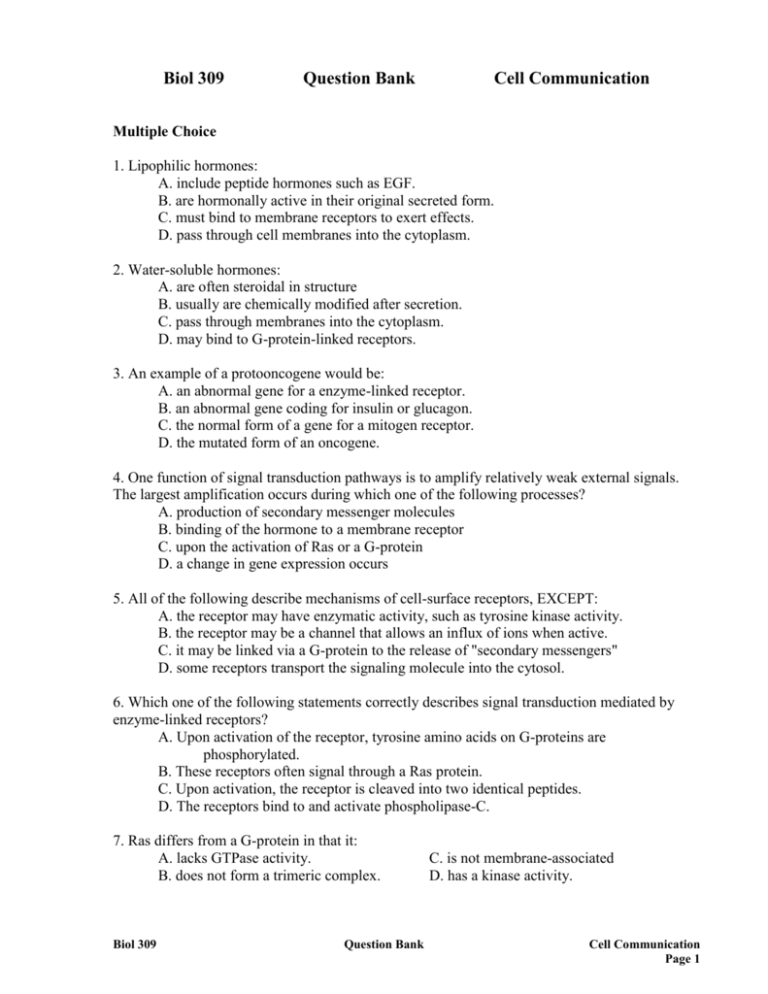
Biol 309 Question Bank Cell Communication Multiple Choice 1. Lipophilic hormones: A. include peptide hormones such as EGF. B. are hormonally active in their original secreted form. C. must bind to membrane receptors to exert effects. D. pass through cell membranes into the cytoplasm. 2. Water-soluble hormones: A. are often steroidal in structure B. usually are chemically modified after secretion. C. pass through membranes into the cytoplasm. D. may bind to G-protein-linked receptors. 3. An example of a protooncogene would be: A. an abnormal gene for a enzyme-linked receptor. B. an abnormal gene coding for insulin or glucagon. C. the normal form of a gene for a mitogen receptor. D. the mutated form of an oncogene. 4. One function of signal transduction pathways is to amplify relatively weak external signals. The largest amplification occurs during which one of the following processes? A. production of secondary messenger molecules B. binding of the hormone to a membrane receptor C. upon the activation of Ras or a G-protein D. a change in gene expression occurs 5. All of the following describe mechanisms of cell-surface receptors, EXCEPT: A. the receptor may have enzymatic activity, such as tyrosine kinase activity. B. the receptor may be a channel that allows an influx of ions when active. C. it may be linked via a G-protein to the release of "secondary messengers" D. some receptors transport the signaling molecule into the cytosol. 6. Which one of the following statements correctly describes signal transduction mediated by enzyme-linked receptors? A. Upon activation of the receptor, tyrosine amino acids on G-proteins are phosphorylated. B. These receptors often signal through a Ras protein. C. Upon activation, the receptor is cleaved into two identical peptides. D. The receptors bind to and activate phospholipase-C. 7. Ras differs from a G-protein in that it: A. lacks GTPase activity. B. does not form a trimeric complex. Biol 309 Question Bank C. is not membrane-associated D. has a kinase activity. Cell Communication Page 1 8. Which one of the followings events occurs earliest in an enzyme-linked signal transduction pathway: A. autophosphorylation of receptor tyrosines occurs B. two of the receptors link to form a dimer. C. phosphorylation of cytoplasmic kinases occurs. D. other proteins bind and form a large signaling complex. 9. Ca++, cAMP, inositol 1,4,5-triphosphate, and diacylglycerol are all: A. extracellular signaling molecules B. inhibitors of signaling pathways C. activators of G-proteins D. secondary signaling molecules 10. Activated G-proteins: A. are released into the cytoplasm to activate gene regulatory proteins. B. activate other proteins that produce secondary messenger molecules. C. phosphorylate tyrosine amino acids on specific target proteins. D. must continuously hydrolyze GTP to GDP to remain active. 11. Which one of the following statements DOES NOT correctly describes G-proteins? A. Energy for their activity comes from GTP molecules. B. They become activated by interaction with ‘7-pass’ receptors. C. G-proteins are membrane associated proteins. D. G-protein activation can be coupled to release of IP3 or cAMP into the cytoplasm. 12. After interacting with a cell-surface receptor that signals activation to a trimeric G-protein, the first event that happens is: A. GTP is hydrolyzed to produce GDP. B. Tyrosines on the G-protein become phosphorylated. C. the G-protein dissociates into a b- and ag-subunits. D. GTP replaces GDP in the a-subunit 13. Activation of the rod-type photoreceptor cells in the retina will cause all of the following changes, EXCEPT: A. opening of Na+ channels in the photoreceptor cells. B. a decrease in the level of cGMP in the cell. C. activation of a G-protein called transducin. D. a conformational change in the photoreceptor, rhodopsin. E. release of neurotransmitters from the cell. 14. The cholera toxin enters cells of the intestinal lining where it binds to the a-subunit of a Gprotein blocking its ability to hydrolyze GTP. The effect of the toxin on the G-protein will be: A. irreversible binding of the G-protein to the receptor. B. an inability to bind to GDP and become activated. C. an inability to bind to adenylate cyclase. D. the G-protein will remain permanently activated. True/False Biol 309 Question Bank Cell Communication Page 2 1. Glucagon and insulin are examples of water-soluble peptide hormones. 2. Receptors for steroidal hormones are found within cells, often in the nucleus. 3. EGF is an example of a lipophilic hormone. 4. In their active form, G-proteins are bound to GDP. 5. Tyrosine kinase receptors are typically activated when coupled in a dimeric form. 6. G-protein-linked transduction pathways operate through a Ras protein step. 7. The enzymes phospholipase-C and adenylyl cyclase both produce secondary messenger molecules. 8. Enzyme-linked receptors may signal through a transduction pathway, or activate a gene regulator protein directly. 9. After binding to an enzyme-linked receptor, a signaling molecule must then be transported into the cytoplasm for its effects to be exerted. 10. The same cell-surface receptor found on different cells can trigger different responses to the same signaling molecule. 11. Inositol-triphosphate can act as both a signaling molecule and a membrane docking site for peripheral proteins. 12. Upon activation, tyrosine-kinase receptors perform ‘self-phosphorylation.’ 13. Secondary messengers released during signaling pathways often lead to the activation of proteins such as protein kinase-A and protein kinase-C. Matching 1. Enzyme ___ tyrosine kinase ___ GTPase ___ andenylyl cyclase ___ phosopholipase-C ___ protein phosophatase Property A. the product of its reaction is a secondary signaling molecule B. typical activity of an enzyme-linked receptor C. produces inositol 1,4,5-triphosphate D. removes covalently linked phosphates E. activity of G-protein a-subunit Fill in, etc 1. Name the three major groups of cell membrane receptors: Biol 309 Question Bank Cell Communication Page 3 2. _____ is a membrane bound ____ binding protein that resembles the ____ subunit of Gprotein. 3. Hydrophobic hormones such as testosterone typically bind to ___________________ receptors, whereas soluble peptide hormones bind to _________________________ receptors. Cell signaling is said to be ____________________ when the source and target of a hormone are distantly located within the body, __________________ signaling occurs among cells in close proximity to each other. (paracrine, endocrine, autocrine, cell-surface, intracellular, extracellular) 4. The steroidal molecules _______________ and ________________ are examples of lipophilic hormones. 5. A mutation to a ______________________ gene could lead to an increased rate of mutation of other genes. The normal form of a G-protein linked to regulation of cell division would be classified as a _________________________, which if mutated to become constitutively activated would then be classified as a ________________________. 6. Identify the components of the signal transduction pathway identified in this diagram as: A. _____ B. _____ C. _____ D. _____ E. _____ 7. Identify the enzymes and metabolites identified in this pathway as: A._____ B. _____ C. _____ D. _____ E. _____ 8. Identify the components of the signal transduction pathway identified in this diagram as: A. ____ B. ____ C. ____ D. ____ E. ____ Biol 309 Question Bank Cell Communication Page 4 9. Earlier in the semester we stated that hormone receptors must have ‘multi-pass’ transmembrane domains in order to convey an external signal across a membrane. Why? Nevertheless, tyrosine kinase-linked receptors have single-pass membrane domains. Explain how they can function as cell surface receptors. 10. Antibodies can be generated that bind to cell-membrane hormone receptors, and binding of the antibody to the receptor will cause activation of the signaling pathway. Antibodies are proteins with a ‘Y’- shape. They have the ability to bind with high specificity to specific target antigens; each antibody protein has 2 binding sites, one each at the ‘upper’ ends of the ‘Y’. When treated with a protease, antibodies can be cleaved into antigen binding (Fab) and nonbinding (Fc) domains (see Figure). In liver cells, insulin triggers glucose uptake, and glucagon leads to glucose secretion. In a particular experiment, two types of antibodies were produced: one that recognized the insulin receptor, an enzyme-linked tyrosine kinase, and one that binds the glucagon receptor, which is G-protein-linked. Cultured liver cells were then treated with intact antibodies, with (Fab) subunits, or both, and the results are presented in the following table. In each experiment the total number of antigen binding sites was the same. A B C D E F Treatment Anti-gluc-receptor whole Ab Anti-gluc-receptor Fab Anti-gluc-receptor whole Ab + Fab Anti-ins-receptor whole Ab Anti-ins-receptor Fab Anti-ins-receptor whole Ab + Fab Results (nmole glucose) uptake release -25 -28 -28 40 -0 -16 -- Answer each of the following questions: A. Do the results for treatment with anti-glucagon-receptor and anti-insulin-receptor agree with your expectations. Explain. B. Why does treatment with anti-glucagon-receptor Fab lead to glucose release at about the same level as whole antibody, whereas anti-insulin Fab has no effect compared to the whole antibody? C. Why does the combination of anti-glucagon whole antibody + Fab have an effect similar to that of either alone, whereas the combination of anti-insulin whole antibody + Fab is less effective than whole antibody alone? 11. Identify three similarities and three differences between G-proteins and Ras. Biol 309 Question Bank Cell Communication Page 5 12. Suppose you were to study the signaling pathway in an excised intestinal epithelium layer in an in vitro system. Referring to the following diagram, which of the treatments and genetic manipulations would be expected to increase the production of IP3? Explain all four answers. A. A mutation to the phospholipase-C that strengthens its interaction with the G-protein asubunit. B. Increasing the cholesterol content of the membrane. C. A mutation to the receptor that weakens its binding to the signal molecule. D. Adding a non-hydrolyzable analog of GTP. E. A mutation to the G-protein a-subunit that weakens its affinity for GDP. Biol 309 Question Bank Cell Communication Page 6
